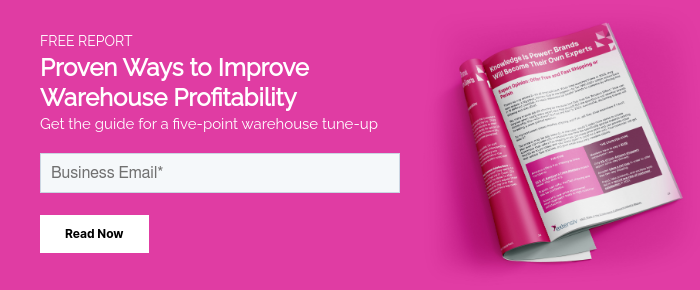With the new year beginning, many third-party logistics (3PL) warehouses have shifted from peak season fulfillment mode to focus on growth and planning. While it may seem easy to pick a percentage of growth your 3PL wants to achieve, creating a structured approach to planning and achieving growth will offer your warehouse the greatest chance of success achieving or exceeding growth objectives.
In 2021, 85% of 3PL warehouses grew, but only 23% grew order volume more than 50%. The Third-Party Logistics Warehouse Benchmark Report outlines both order volume and profitability growth, as well as key opportunities for growth in 2022. Nearly 73% of 3PLs view acquiring new customers as the top opportunity for growth in 2022, with 52% citing ecommerce growth and 47% indicating automating warehouse processes as top growth opportunities as well.
While knowing this data presents helpful benchmarks for growth, creating an explicit growth plan can offer great returns.
How Can 3PL Warehouses Develop Growth Targets?
Before setting growth targets, 3PLs should consider current customer growth, existing pricing structure, infrastructure available for growth, and areas for optimization.
Assess Existing Customer Growth
- Conduct business and volume projection review with each customer to understand growth objectives and planned volume increases.
- Understand any changes in product line or inventory that customers plan for the year to determine additional space or labor needs.
- Calculate impact of changes on revenue and profitability by customer.
Analyze Current Pricing Structure
- Start by understanding if your current pricing structure drives the margin your 3PL needs for profitable growth. Have your costs increased? How much, if any, have you passed through to your customers?
- Consider what pricing adjustments you need to make. Has storage become less available, and therefore more valuable? Do your customers leave slow-moving inventory in your facility taking up valuable space?
- Implement revised pricing and calculate the impact on your growth percentage.
Assess Growth Potential
- Evaluate how much available space you have to add new client inventory into your warehouse. Consider the current capacity and how much you will need to allocate for existing customer growth versus new customer additions. Do you have any limitations on capacity that might inhibit growth?
- Review your available workforce and how much additional throughput you can generate with the same team and systems.
- Identify current 3PL warehouse market growth trends to understand the average growth rates. Do you want to grow with the market or outpace it?
Once you have identified what revenue and volume growth will naturally flow from existing customers, how your pricing will impact growth rates, any limitations you might have from space or labor, and where you want your growth to be versus the market, you can begin planning broader growth strategies around new customer acquisition.
How Can 3PLs Develop Practical New Customer Acquisition Strategies?
As you cement your 3PL warehouse’s growth targets, building the plan for how to achieve that growth will prove critical in your success or failure. To build out the growth plan, you’ll need to consider where you need to diversify offerings, how you can optimize profitability and processes, which channels will drive new customer acquisition, and how you can gain alignment on growth commitments internally.
Determine Areas for Diversification
- Review your current service offerings. Will you need to add new services (e.g., kitting and assembly, returns management, etc.) to attract new customers? What warehouse technology and personnel will be needed to support these new offerings?
- Consider what verticals (e.g., nutraceuticals, cold storage, bulk materials, etc.) of product types you want to support. By expanding verticals, it can open entirely new markets and customers up to your business.
- Analyze what fulfillment types (e.g., B2B, B2C, omnichannel, etc.) you can support. If you need to modify processes to create a more omnichannel approach, your target market could expand exponentially.
Explore Areas to Optimize Profitability or Warehouse Efficiency
- Consider your warehouse technology and how well it has performed. Can your 3PL automate additional activities with a warehouse management system (WMS) or mobile barcode scanning? Identify key warehouse software that can help your 3PL improve throughput or minimize labor reliance.
- Review your warehouse technology ecosystem. What integrations do you have today? And what integrations will your existing (and new) customers need to increase volumes in the coming year? Ensure that your WMS partner can integrate with the hundreds of order sources brands need to drive volume for the coming year.
Plan for Customer Acquisition
- Assess existing lead generation channels (e.g., outbound sales, website, paid ads, referrals, etc.) for new customer acquisition. Do you need to invest in any programs, materials, or personnel to drive interest?
- Review sales quotas and processes. Will your current sales team get you to the growth targets with their current quotas? Or do you need to adjust sales quotas and/or increase personnel?
Develop Communication Plan
- Share your 3PL’s growth goals with the entire organization. By communicating with the warehouse team, you can get the team aligned and prepared for upcoming changes in volume or processes.
- Assign owners to key parts of your growth strategy to drive accountability and measurement.
To Successful Growth
To learn more about the largest opportunities for growth in the coming year and how your 3PL warehouse compares against competitors, download the Third-Party Logistics Warehouse Benchmark Report.








